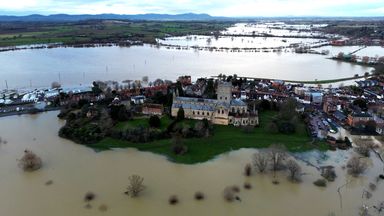High-risk flood areas face cuts to key council services as flood defence costs spike
Councils are tasked with funding flood alleviation but with rising costs they have warned key services such as adult social care or waste collection could be impacted.

People living in areas at the highest risk of flooding face cuts to key services due to a sharp rise in flood defence costs, councils have warned.
The government is being urged to overhaul funding for the bodies overseeing flood alleviation as soaring costs have seen an average rise of 28% over the past two years, according to data from the District Councils’ Network, which represents 169 English councils.
Higher energy and fuel prices – needed for pumping stations – increasingly extreme wet weather and wage increases are the main causes of the cost of flood defences being pushed up for the current 2024/25 financial year.
Public bodies called internal drainage boards are responsible for reducing flood risks and managing water levels to protect nearly one million properties across England, 50,000 farms, 56 power stations, and hundreds of miles of motorway and railway.
Councils have to collect funding for those internal drainage boards and do so through council tax, meaning areas at severe flood risk have to use more of taxpayers’ money for flooding than areas without any, or with little flooding.
With a large increase in costs for the internal drainage boards, councils are warning they will have to dig into funds meant for everything from waste collection to adult social care and libraries to fund flood defences.
The council areas facing the highest increases are:
East Lindsey, Lincolnshire – £1.37m increase (35%)
Boston, Lincolnshire – £710,000 increase (33%)
South Holland, Lincolnshire – £580,000 increase (20%)
Doncaster, South Yorkshire – £500,000 (35%)
Kings Lynn and West Norfolk – £420,000 (16%)
Boston Borough Council will have to spend 22% of its £12.76m annual net budget on the drainage levy – 61% of the £4.33m council tax it collects.
Read more:
Climate change made UK’s soggy winter even wetter
Britain’s smallest house at risk due to climate change
As councils cannot increase council tax above annual thresholds without a referendum, the option to raise the funding by doing so is not really an option, and would be very unpopular.
Environment Secretary Steve Reed said protecting people from the dangers of flooding is one of his five top priorities.
Tracey Garrett, chief executive of the Flood Response Forum which helps people deal with flooding, said the UK is dealing with more and more flooding each year, so people will need “more and more support”.
“More resources to support flooding would be welcome,” she told Sky News.
“It’s very encouraging to hear protecting people from flooding is part of the government’s key priorities but the proof will be in the pudding.”
Paul Redgate, chair of the Local Government Association’s internal drainage board levies group, and deputy leader of South Holland District Council, is part of a group which secured a commitment from the previous government to look at a long-term solution for flood defence funding.
“I’m hoping this new government will stick to that,” he told Sky News.
“Local authorities are making very difficult decisions to keep people’s homes safe and then whichever services they have to take funding from, they need to be kept safe first and foremost.”
Be the first to get Breaking News
Install the Sky News app for free


Sam Chapman-Allen, chairman of the District Councils’ Network, said: “It is only by properly funding flood prevention that defences can be maintained over vast swathes of the country and we avoid catastrophic flooding threatening life and livelihood.
“We urge ministers to work with us to ensure those living in areas at risk of flooding are not unfairly penalised through the form of higher tax bills and a reduction in the services upon which we all depend.”
A DEFRA spokesman told Sky News: “Protecting communities around the country from flooding is an absolute priority for this government, which is why we will be launching a Flood Resilience Taskforce to turbocharge the delivery of flood defences, drainage systems and natural flood management schemes.
“The government will also take steps to ensure we are building more high-quality, well-designed, and sustainable homes and creating places that increase climate resilience and promote nature recovery.”


